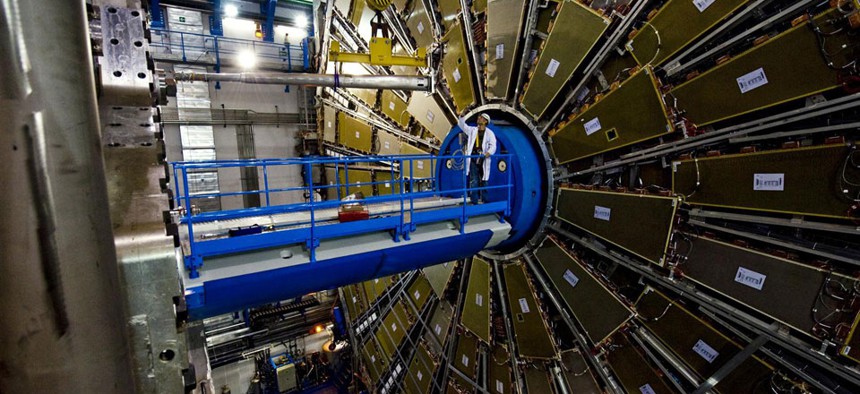The Chase for the Higgs Boson Is About to Get Bigger, Faster, and Costlier—but We Need It

Preparation of the ATLAS detector at the Large Hadron Collider CERN/AP
Big science is about to get a whole lot bigger.
I’ll admit it: I love Big Science. Experiments at epic proportions, particularly when they involve exploration into other universes, dimensions, and scales, are hard to resist. This past week on a visit to Geneva, I had the chance to get up close to an icon of Big Science, the 17-mile wide particle accelerator run by CERN , also know as the Large Hadron Collider (LHC). One of the biggest scientific construction projects in history, this pan-European particle physics research center is so large it stretches across the Franco-Swiss border and is home to 10,000 scientists. While it was amazing from many angles, it may not be the biggest science we yet attempt.
The stats on the equipment we faced are staggering. To validate the existence of the Higgs boson , the LHC’s most recent undertaking, scientists pumped 8 TeV, or 8 trillion electron volts of energy, into protons making some 11,000 turns a second around the 17-mile loops of underground tunnels at the LHC. According to CERN physicist Samer Kilani, at top speed, those protons hit 99.999% of the speed of light before crashing together and producing evidence of the Higgs. Such a capacity is physically necessary to venture to the edge of discovery, Kilani told us: “In order to get extreme physics we need extreme technologies.”
Our chance to visit came thanks to CERN’s shutdown of LHC experiments for a two-year, $100-plus million upgrade known as Long Shutdown 1, or LS1. When the LHC is fully operational, no members of the public can get as close. Once the LS1 is completed in early 2015, the upgrades will allow the LHC to push power up to 14 TeV, giving physicists more collision power, resulting in more extensive data to work with.
Even as engineers are adding more equipment to the massive machine in order to increase its power, and expand the scope of possible discoveries it could make, researchers from CERN are gathering this week in Geneva to discuss the possibility of building an even larger particle collider that would dwarf the LHC in both size and power.

With a proposed diameter of 50-60 miles, TLEP, or Triple Large Electron-Positron Collider, would stretch well under the city of Geneva, Switzerland, under Lake Geneva, and deeper into neighboring France. It would also raise the power pumped into particle collision experiments by more than 10 times, to 100 TeV. According to its backers, TLEP would provide a greater clarity about the properties of the Higgs boson and the so-called Higgs field from which it is created. Rough estimates put the cost of building the main parts of the TLEP at around $3.3 billion. An initial paper on the project indicates early experiments could be running in the new facility by 2030.
For almost a decade now, the euro zone has been in a deep funk and is only just starting to show some signs of recovery . Money has been tight, and the $13 billion that finding the Higgs boson is estimated to have cost could have gone to other needs. Costs for just the LS1 upgrades will run over 50 million Swiss francs ($56 million). The same arguments of unnecessary spending being leveled at India’s recent Mars launch while poverty still bites much of the country could apply to the LHC and its potential big brother, TLEP.
Kilani pointed out that endeavors such as CERN’s deliver important benefits for its member countries across Europe and for the world at large: pushing technology beyond known limits to benefit science, training the next generation of scientists not only from Europe but from around the world (Kilani himself is Jordanian), and maintaining international cooperation in science. If my own visiting group—comprising 10 nationalities, including French, Israeli, American, Australian, Turkish, Dutch and Russian, amongst 20 of us—is any indicator, coming together in the face of Big Science is a positive bonding experience. Having dozens of countries working cooperatively on nuclear and particle physics, rather than competitively, seems like a good idea to me.




Reprinted with permission from Quartz . The original story can be found here .





